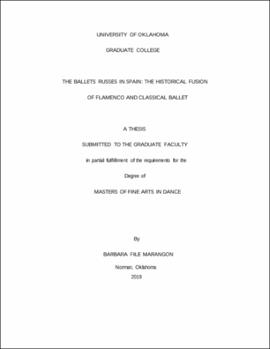| dc.contributor.advisor | Holt, Mary Margaret | |
| dc.contributor.author | File Marangon, Barbara | |
| dc.date.accessioned | 2019-05-10T16:06:54Z | |
| dc.date.available | 2019-05-10T16:06:54Z | |
| dc.date.issued | 2019 | |
| dc.identifier.uri | https://hdl.handle.net/11244/319691 | |
| dc.description.abstract | The objective of this project was to discover the connection between Flamenco Dance and Classical Ballet and if it created a third dance form. What did Flamenco Dance contribute to the Ballets Russes on their Spanish detour from 1917-18? What did the famous ballet company give to Flamenco? These were questions discussed. The two nomadic groups met through the interest and passion of one choreographer, Leonide Massine. Through the practice of Flamenco Dance, I discovered how a ballet choreographer/dancer experienced this dance form. The result is Massine's Three-cornered Hat ballet melding Flamenco and Classical Ballet.The significance of this study stimulates future research in the hybrids of other dance forms. | en_US |
| dc.rights | Attribution-NoDerivatives 4.0 International | * |
| dc.rights.uri | https://creativecommons.org/licenses/by-nd/4.0/ | * |
| dc.subject | Ballets Russes | en_US |
| dc.subject | Flamenco | en_US |
| dc.subject | Three-cornered Hat | en_US |
| dc.subject | Massine | en_US |
| dc.title | The Ballets Russes in Spain: The Historical Fusion of Flamenco and Classical Ballet | en_US |
| dc.contributor.committeeMember | Dossev, Boyko | |
| dc.contributor.committeeMember | Palmer, Allison | |
| dc.contributor.committeeMember | Holguín, Sandie | |
| dc.date.manuscript | 2019-04 | |
| dc.thesis.degree | Master of Fine Arts in Dance | en_US |
| ou.group | Weitzenhoffer Family College of Fine Arts::School of Dance | en_US |

